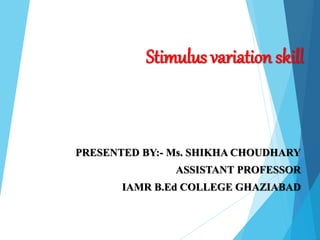
STIMULUS VARIATION SKILL MICRO TEACHING SKILL.pptx
- 1. Stimulus variation skill PRESENTED BY:- Ms. SHIKHA CHOUDHARY ASSISTANT PROFESSOR IAMR B.Ed COLLEGE GHAZIABAD
- 2. MEANING OF STIMULUS VARIATION Stimulus refers to an agent, action or condition that elicits, accelerates or rouses to physiological or psychological action, activity or responses. Variation means changing these stimuli to explain content lively and remove the boredom from the classroom teaching. Stimulus Variation the set of teacher behaviors that tend to secure and sustain pupils attention in the skill of stimulus variation.
- 3. Important word Meaning Stimulating = Inspiring Focus = Centre Variation = Deviation Pattern = Prototype Movement = Changing the position Verbal = Oral Gesture = Signal
- 4. Objectives 1.To enhance the students capacity of thinking. 2. To enhance the active involvement of the students in the teaching. 3. To enable the students for understanding the concept. 4. To enhance liveliness in teaching. 5. To enhance continuous thinking of students for understanding concepts. 6. To grab the attention of the students. 7. To minimize students mental fatigue and boredom. 8. To learn how to use teaching aids.
- 5. Components Focusing Gestures Voice modulation Pausing Change in Interaction Style Switching sensory channel (oral/visual)
- 6. Components FOCUSING:- The teacher draws the attention of the pupils to the particular point in the lesson either by using verbal or gestural focusing. In verbal focusing the teacher makes statements like, “look here” “listen to me” “note it carefully”. In gestural focusing pointing towards some object with fingers or underlining the important words on the black board.
- 7. Components GESTURE:- These include movements of head, hand and body parts to arrest attention, to express emotions or to indicate shapes, sizes and movements. All these acts are performed to become more expressive. The teacher's gestures - the teacher's body movements - which communicate certain meaningful ideas to the students. Move hands and fingers to describe things, measurements, etc. While talking with the students, show agreements by nodding heads so as to encourage the students to go on explaining; Show adoration or wonder by raising eyebrows high so as to show interest in what the students are talking about. Claps hands to attract the students' attention or to show happiness, wonder etc.
- 8. Components VOICE MODULATION:- Change in Speech Pattern. The change in the speech pattern makes the pupils attentive and creates interest in the lesson. Speak using different speech patterns to avoid boredom. Do not be monotonous. Speak attractively and energetically. Speak loudly enough for the students at the back to hear what the teacher is saying, but not too loud so that the students at the front get shocked.
- 9. Components PAUSING:- This means “stop talking” by the teacher for a moment. When the teacher becomes silent during teaching, it at once draws the attention of the pupils with curiosity towards the teacher. The message given at this point is easily received by the pupils. Silence/pausing can be used in different ways:- To emphasize an important point. To create suspense & arouse thinking. To provide time for students to think for something before they response. To give students time to make notes before continuing with the lecture or dictation. To show disapproval for student misbehavior.
- 10. Components CHANGE IN INTERACTION STYLE:-In the classroom the following three styles of interaction are possible:- Teacher ↔ class (Teacher talks to class and vice versa) Teacher ↔ Pupil (Teacher talks to pupil and vice versa) Pupil ↔ pupil (Pupil talks to pupil)
- 11. Components SWITCHING SENSORY CHANNEL (ORAL/VISUAL):- The teacher gives information to the class verbally about something. This is called oral medium.When the teacher is showing maps, charts and object without saying something. This is called visual medium. If the teacher is giving information to the pupils through any one medium (oral, visual, oral visual) for a long time., it is possible that the students may lose attention to what the teacher is conveying to them. Therefore it is essential for the teacher to change medium rapidly in order to secure and sustain pupils’ attention to what he says. There are three types media :- 1.Oral ⇄ oral –visual :- when the teacher while speaking shows objects, charts and models and explains their various parts. It is switching from oral to oral- visual. 2. Oral ⇄ visual :- when the teacher while speaking, shows objects, maps, charts, globe etc. It is switching form oral to visual. 3. Visual ⇄ oral – visual when the teacher demonstrates the experiment silently and then explains the phenomenon with the help of charts, maps, diagram etc. It is visual- oral switching. These devices are used interchangeably to secure and sustain pupils’
- 12. DO’S Purposeful Questions. Dialogues in large and small groups. Assisted Performance and Scaffolding. Assistance with question, clarifications. Physical demonstration, model. Talking aloud with gestures. Interaction with students.
- 13. Don’ts Avoid Unnecessary movements. To come forward & go backward unnecessary. To seat on the table. To touch head or hear. To touch lips with the tongue. To stand on the same place for long time. Avoid board work. Repetition of the same activity. To move shoulders. To rotate neck again and again. To move the eyebrow To play with chalks.